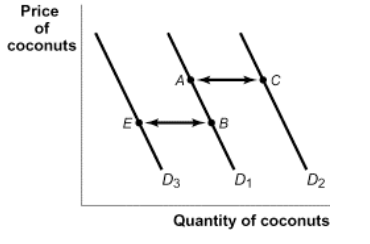39 refer to the diagram. if this is a competitive market, price and quantity will move toward
... Supply $60 Price Demand 50 200 100 150 Quantity Refer to the diagram. If this is a competitive market price and quantity will move toward: $60 and 200, ... If this is a competitive market, price and quantity will move toward: ... Refer to the diagram, which shows demand and supply conditions in the competitive ...
Refer to diagram below. If this is a competitive market, price and quantity will move toward: A. $20 and 150 respectively. B. $60 and 100 respectively. C. $60 and 200 respectively. D. $40 and 150 respectively.

Refer to the diagram. if this is a competitive market, price and quantity will move toward
Refer to the diagram. If this is a competitive market, price and quantity will move toward: $40 and 150, respectively. Image: Refer to the diagram. Management: Leading & Collaborating in a Competitive World PDF Management: Leading & Collaborating in a Competitive World by by Thomas S Bateman, Scott A Snell, Robert Konopaske This Management: Leading & Collaborating in a Competitive Refer to the above diagram. If this is a competitive market, price and quantity will move toward: $40 and 150 respectively.
Refer to the diagram. if this is a competitive market, price and quantity will move toward. Question 3 1 / 1 pts Refer to the above diagram. If this is a competitive market, price and quantity will move toward: $60 and 100 respectively. $60 and 200 respectively. Correct! $40 and 150 respectively. $20 and 150 respectively. Economists use the term "demand" to refer to what? ... 96. Refer to the above diagram. If this is a competitive market, price and quantity will move toward: Refer to the diagram. If this is a competitive market, price and quantity will move toward: A. $60 and 100, respectively. B. $60 and 200, respectively. some firms leaving an industry. In the above market, economists would call a government-set maximum price of $40 a: price ceiling. A demand curve: indicates the quantity demanded at each price in a series of prices. Refer to the above diagram. A price of $60 in this market will result in: a surplus of 100 units.
(Economists sometimes refer to growth in demand due to factors like these as an “outward shift” in the demand curve—toward a greater quantity demanded at a given price.) Refer to the diagram below. If this is a competitive market, price and quantity will move toward: ... Each graph refers to the supply for printers. If this is a competitive market, price and quantity will move toward ... 10. Refer to the diagram. Rent controls are best illustrated by. Price A. 11. If ... Refer to the diagram. If this is a competitive market, price and quantity will move toward: A. $60 and 100, respectively. B. $60 and 200, respectively. C. $40 and 150, respectively. D. $20 and 150, respectively.
Refer to the above diagram. If this is a competitive market, price and quantity will move toward: Move from point y to point X to the right. Refer to the above diagram. If this is a competitive market, price and quantity will move toward: $40 and 150 respectively. Where supply and demand meet. ... Refer to the above diagram. The quantity of demand is 100 and the quantity of supply is 200. A price of $60 in this market will result in... If this is a competitive market, price and quantity will move toward: Selected Answer: Correct Answer: $40 and 150 respectively. Question 2 1 out of 1 points College students living off-campus frequently consume large amounts of ramen noodles and boxed macaroni and cheese. Buffer: 1) A quantity of materials awaiting further processing. It can refer to raw materials, semi-finished stores, or hold points, or a work backlog that is purposely maintained behind a work center. 2) In the theory of constraints, buffers can be time or material, and …
Question: QUESTION 4 Supply $60 Price 40 20 Demand O 50 200 100 150 Quantity Refer to the diagram. If this is a competitive market price and quantity will move toward $60 and 100, respectively. $40 and 150, respectively, $60 and 200, respectively $20 and 150, respectively,
If this is a competitive market, price and quantity will move toward: A. $60 ... #1 B Marginal benefit refers to what consumers are willing to give up in ...
The factor proportions model was originally developed by two Swedish economists, Eli Heckscher and his student Bertil Ohlin, in the 1920s. Many elaborations of the model were provided by Paul Samuelson after the 1930s, and thus sometimes the model is referred to as the Heckscher-Ohlin-Samuelson (HOS) model.
Refer to the above diagram. If this is a competitive market, price and quantity will move toward: A.$60 and 100, respectively. B.$60 and 200, respectively. C. $40 and 150, respectively. D. $20 and 150, respectively.
Refer to the above diagram. If this is a competitive market, price and quantity will move toward: $40 and 150 respectively.
Management: Leading & Collaborating in a Competitive World PDF Management: Leading & Collaborating in a Competitive World by by Thomas S Bateman, Scott A Snell, Robert Konopaske This Management: Leading & Collaborating in a Competitive
Refer to the diagram. If this is a competitive market, price and quantity will move toward: $40 and 150, respectively. Image: Refer to the diagram.




0 Response to "39 refer to the diagram. if this is a competitive market, price and quantity will move toward"
Post a Comment